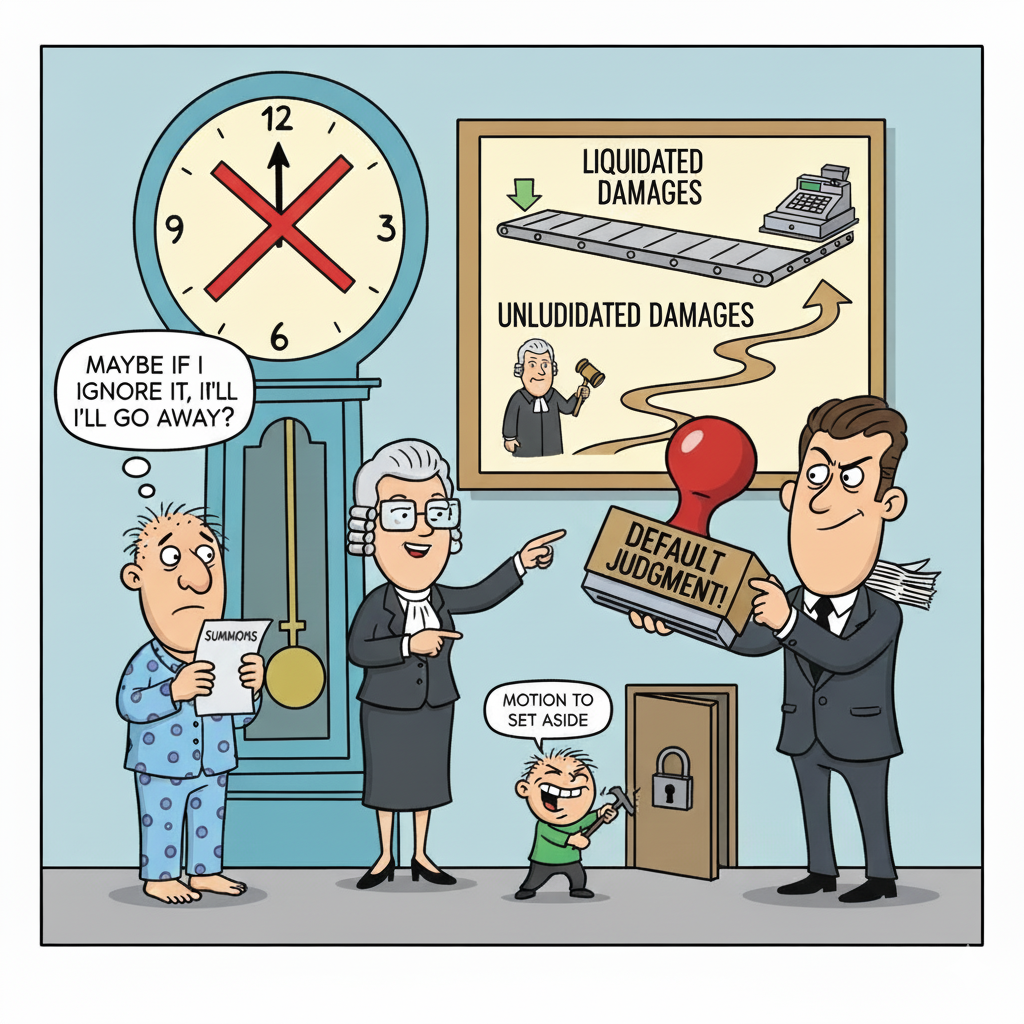When you start a lawsuit in the Ontario Small Claims Court, you expect the defendant to respond. But what if they don’t? What if your claim is met with silence?
The Rules of the Small Claims Court are very clear: once a defendant is served with a claim, they have 20 days to deliver a Defence. If they miss that deadline, the plaintiff can ask the court to note the defendant in default—a crucial procedural step that cuts off the defendant’s right to participate in the case.
In simple terms: no Defence = no voice in court.
Below is a practical, step-by-step guide to noting a defendant in default and obtaining a default judgment, along with key considerations and common pitfalls.
What “Default” Actually Means
“Default” means the defendant failed to meet a required procedural step: filing a Defence on time. Once noted in default, the defendant:
- Can no longer file a Defence
- Cannot take part in the litigation (unless the default is later set aside)
- May have a judgment issued against them without a trial
Part 1: How to Note the Defendant in Default
Before you can request a default judgment, the defendant must first be officially noted in default. Here are the required steps.
1. Prepare and File Your Claim (Form 7A)
Begin by drafting your claim using Form 7A. The claim must state the amount you are seeking and the legal and factual basis for your claim.
2. Issue the Claim With the Court
Filing the claim at the court office “issues” it, meaning it becomes an official court document with a file number.
3. Properly Serve the Defendant
Service is critical. You must deliver the claim to the defendant strictly in accordance with the Small Claims Court Rules. Only certain service methods are allowed—if you don’t follow them, your next steps will fail.
4. Prove Service With an Affidavit of Service
After service, you must swear or affirm an Affidavit of Service describing how, when, and where the claim was served. This affidavit must be in the proper form and accurate.
5. Request the Court Clerk to Note the Defendant in Default
If no Defence is filed within 20 days, you may file a Request to Note in Default along with your Affidavit of Service.
The clerk will review it and—if everything is in order—will note the defendant in default.
Once that happens, the defendant cannot file a Defence unless they later bring a successful motion to set aside the default.
Part 2: How to Obtain a Default Judgment
After noting the defendant in default, you may seek a default judgment. The process depends on the type of damages you are claiming.
There are two categories of damages in Small Claims Court:
a. Liquidated Damages
These are amounts that can be calculated precisely—for example:
- Contractual debts
- Outstanding invoices
- Amounts fixed by a written agreement
b. Unliquidated Damages
These require the court to determine the appropriate amount, such as:
- Pain and suffering
- Damages for copyright breach
- Compensation for troubles and inconvenience
- Property damage where the value must be established
Default Judgment for Liquidated Amounts
If your claim is for a fixed, calculable amount, you may obtain judgment by filing Form 11B (Request for Default Judgment).
The court clerk reviews your documents and, if satisfied, signs the judgment. This judgment is immediately enforceable against the defendant.
Default Judgment for Unliquidated Amounts
Unliquidated damages require additional evidence. There are two options:
1. Motion in Writing
You may file a written motion supported by an affidavit explaining:
- The amount you seek
- How you calculated that amount
- The facts supporting your claim
If the judge is satisfied, a judgment may be issued based solely on the documents.
2. Assessment Hearing
Alternatively, you may ask the court to schedule an assessment hearing. At this hearing, you must attend and present evidence—often including witness testimony—supporting the amount of damages requested.
Court Fees
Every procedural step—from issuing the claim to requesting default judgment—comes with a separate court fee. These amounts change periodically, so check the current fee schedule before filing.
Can a Defendant Undo a Default Judgment?
Yes. Being noted in default or having a default judgment issued does not necessarily end the case for the defendant.
A defendant may bring a motion to set aside:
- The noting in default
- The default judgment
- Or both
The court will grant such a motion only if certain conditions are met. This topic is substantial enough for its own detailed article, which I will address in a future post.
Final Thoughts
Not receiving a Defence from a defendant can be frustrating—but it also opens a clear, structured path for obtaining a judgment without a trial. By following the proper procedures for service, documentation, and filings, plaintiffs can move their case forward efficiently.
If you are navigating this process or dealing with a defendant who won’t respond, a licensed paralegal can help ensure each step is handled correctly and in compliance with the Small Claims Court Rules.







